Star Wars: Jedi Starfighter Q&A
We talk with LucasArts about the upcoming sequel to Star Wars Starfighter.
Following LucasArts' recent announcement of the next installment in the Starfighter franchise, we were able to sit down and talk with director Daron Stinnett, designer Tim Longo, and producer Rachel Bryant. They were able to give us more insight into what the sequel will offer when it is released next year for the PS2.
GameSpot: Now, Star Wars: Jedi Starfighter is technically Starfighter 2, right?
Tim Longo: Yes, it is a continuation of the story, and we have characters from Starfighter whose stories we're picking up 10 years later.
GS: How much access to Episode II materials have you had?
TL: We have characters from Episode II, as well as craft and locations. I'd say the story itself is similar to Starfighter in that it is a backdrop to Episode II. These are events that are happening at the same time as the Episode II storyline, but on a tangent. We weave in and out of the story, and then, at the end, we climax at the same point the movie does. I'd say, content-wise, about 20 percent of our game deals with aspects that you actually see in the movie. You'll get story, you'll get characters, you'll see things in the movie that you'll see in our game--you'll just be able to play them instead of watch them.
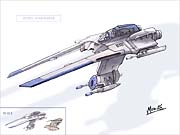
GS: How do you make a compelling game that ties into the movie without spoiling the film?
TL: It's a tricky thing. That's a hard question to answer. We do consider there to be some information from the film that's revealed. It pulls facets from Episode II but isn't a direct mirror of it. You'll see major events from the movie, and you're in there with everyone, but it's not overtly spelling things out. We feel it pays tribute to Episode II and will be a teaser rather than a spoiler. The story is intertwined and it's in the backdrop of it. We have our own thing going, though, because we have characters of our own who aren't in the movie and who we want to develop.
Rachel Bryant: Maybe after seeing the movie and playing the game people will make connections as well.
Daron Stinnett: There are a lot of connections I think people will see clearer once they see the movie. We're dealing a lot with back story and things going on around at the time and doing things to support what George is doing in the movie. There are certainly going to be things they're going to see and hear about that are going to give them clues to the movie. But the movie has such a different focus on the events going on that people are going to be so caught up in that story and the drama--and there's plenty of it--that it's not going to feel like, "Oh, I've already seen the movie in the video game." In some ways, it's similar to the way Starfighter was to Episode I. In fact, I think we've done a better job of tying it in this time than we did on the original Starfighter. I think when players have seen the movie and go back to play the game, they'll feel the ties to the movie.
GS: Who's working on the Jedi Starfighter development team?
TL: We have many of the same people [from the original Starfighter team]. We have a lot of new people also. A lot of the art is almost exclusively new. We have a lot of the same programmers. It's about maybe half and half of returning people and new people. A lot of our level designers are from Starfighter. Darren was the director for Starfighter. I was the lead level designer on Starfighter, and my official title for Jedi Starfighter is designer. So Darren and I work together to come up with the core elements of the game when it comes to all the rule systems, the tuning, and all the unit design. And we worked with Hayden Blackman on the story and developed that in conjunction with Episode II stuff.
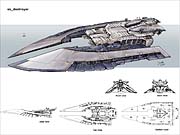
GS: What game engine are you using?
DS: It's the Starfighter engine. We've been spending a lot of time improving the performance [of the engine], and we've increased our ability to do effects by adding a new effects engine to the game.
GS: Will Jedi Starfighter have a more stable frame rate?
DS: I think we can say a higher frame rate. We still have a fundamentally fluctuating frame rate. The reason is because if you lock yourself into a certain frame rate, you're saying the players can never get themselves into a situation where they're seeing so much stuff that the frame rate will drop down. What you have to do in order to do that is make the world very sparse overall and ensure you never get to that point. So we still have a fluctuating frame rate, but what we've done is moved up our limits. In Starfighter, we had hard limits where we'd have indicators come up on the screen where the test department would write bugs up, and they'd either write a priority one bug (has to be fixed), priority two, or priority three, depending on whether a red, orange, or yellow indicator came up. What we've done is moved those limits up, so the "floor" frame rate that we accept is significantly higher than it was in Starfighter. So basically the way to answer that is our expectations are for a better frame rate across the board. A lot of missions will be hitting 60 fps this time, whereas I don't think it was happening very much in Starfighter--we would even get down below 20 once in a while, and we won't be getting down that far in Jedi Starfighter.
GS: What can we expect out of Jedi Starfighter's multiplayer modes? Online play?
TL: That's not in the plan. The big plan for us was to do two-player stuff. Whereas it was a bonus in Starfighter and it's in Starfighter: Special Edition. We decided early on that it was such a big feature and so fun for players that we decided to make it an integral part of the game. So you'll be able to play every mission cooperatively with a friend sitting next to you. The co-op nature of the game, which is teamwork-based, is going to be the main focus. We may eventually have some competitive missions in the bonus missions and such, along the lines of what you see in Starfighter: Special Edition. But the main focus is on playing the story missions themselves cooperatively, and we'll have the missions tuned and balanced for both instances. And there are rewards for both single- and multiplayer that you can only get in one or the other so we can encourage people to play both modes.
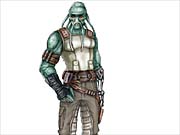
GS: Will the endings differ in the two modes?
TL: The story is essentially the same, but we have weapons and vehicles you can only use in two-player mode.
DS: Other than classic PC flight sims, like Falcon or something like that, I don't think anyone's ever presented cooperative flight gameplay in lighter-style games or consoles, at least to this extent. We thought it would be a real tuning challenge. And what we found is that just the act of sitting down with a friend and playing is so much fun and that kind of social, cooperative thing that it's not really critical that we make the game that much harder so that it's an equal challenge either way. It's really just a different experience when you play by yourself or with a friend, and that alone makes it cool.
TL: We got it running early and we're playing with it so we can see the progress.
GS: If you start a two-player game, will you be locked into finishing the game that way?
TL: Each time you play a mission you can decide to play it single- or multiplayer, and you can go back and play levels you've cleared with another player.
GS: So, outside of cooperative play, will there be some of the multiplayer modes we've seen in Starfighter: Special Edition on the Xbox?
TL: To the extent of how far we go with the competitive stuff--like Starfighter: Special Edition did, where they had the luxury of going through and making that the key element--we are spending more time on the cooperative mode, but we will be able to support stuff like that. But it's hard to say at this point how far we'll go.
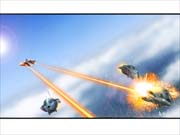
DS: A lot of that stuff from Starfighter--like the very fact that we had multiplayer head-to-head missions--was extra. We had bonus missions that we had planned to do after we finished the story missions. The context of the bonus missions was, with whatever time we had left, we'd ask, "Who's got an idea? Go make it work. If it works, we'll ship it, if it doesn't, we'll cut it." We had a certain group of missions that we really wanted to do as bonus missions, and we knew we were going to do them and get them in the game. Multiplayer was really just a skunkworks project--it wasn't even until we just about shipped the game that we told the people working on it that it was OK to do it at all. So they were working late hours and doing their own thing and everything they could to get that in. That was really Troy, our mission designer, and Andrew, our graphics programmer, who really pushed that. There was even debate right before we shipped the game if we wanted to do it all, even though [multiplayer] was working. We're glad we did, because I think it gave people a taste of the potential we exploited on the Xbox. So this time around, we'll still have that period where we'll be developing bonus missions--what they are yet, we're still not sure, and it really depends on time left and who's got a great idea. Unlike last time, multiplayer will be fully supported. We'll put it on the schedule and plan to ship multiplayer missions, so I think that, although I can't say for sure what we'll be providing, it will be a lot more than what you saw in Starfighter.
GS: How will you incorporate force powers into the game without affecting gameplay?
TL: You'll use the D-pad. We'll have a modifier button that will let you toggle between communicating with your copilots and using the force powers. We labored a bit on how to actually use the force powers, because we also have more weapons on some craft--equal to the amount of force powers as you would have [if you play a Jedi]. So you'll have more secondary weapons to fool with so we have the same issues with both types of craft. The D-pad ended up being the obvious choice--it's really quick and seems fluid while you're playing. We just had a milestone that went really well, and Darren was commenting about how fun it was to use your powers in certain instances and having to pick your battles. The tuning challenge is still upon us because [the powers] can have a major impact on a mission, but they're so dynamic and so fun that we know however we tune them they're going to be enormously fun.
DS: That was a major design criteria--that we get the controls right for those. Tim really worked hard to figure out how we could make it work. We started out with more force powers than we have but cut it down to four since the D-pad is convenient for that.
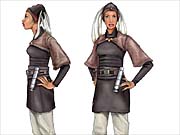
GS: The lead character this time is Adi Galia? Why go with her instead of a better-known character?
DS: It's two things. One, we want to build our own characters, who we can take in directions to present different types of adventures that are of our own design. If we take Obi Wan, we have a hard limit at Episode II because we don't know what happens to him beyond that. We'd also have constraints on where the players can go and what they can do, and we'd have to put them through the same adventures they saw in the movie, and that would put us in a lot of game design constraints that people may not appreciate in the end. One thing we've heard is that people don't want to play the movie, and if we take those characters, we tend to head in that direction. So, having the freedom to make the best possible games is one aspect. The other aspect is developing these characters, who hopefully will live on. A great example is Kyle Katarn from Dark Forces [on the PC]--he's got his own legacy and history now, which couldn't have been done if he was Luke Skywalker.
GS: What kind of extras will you offer?
TL: Another one of our big goals in Jedi Starfighter was to push the reward system quite a bit. As Daron said, toward the end of Starfighter, the bonus missions were as much as we could fit in at the time. This time around, with the forethought that we have, we wanted to push that even farther, so not only will we probably push the bonus missions farther than in Starfighter, but in the long run, we'll also probably have many more bonus craft you can fly, and, time permitting, maybe we can put some new weapons or something like that too. But our bonus-system structure is a lot more developed and gives us the ability to give more out to the players as they play the game more frequently so they feel a sense of reward throughout.
GS: Will the game's structure follow Starfighter's?
DS: Yes.
GS: Any other extras you'd like to mention?
DS: A big focus in the project is to build environments that are more diverse than Starfighter's and have a big impact on gameplay. In Starfighter, we had expansive exterior environments, interior environments, and space, and even within the terrain environments, there was a lot going on there. So one of our focuses is to take it to the next level. We've made some improvements to the sound that we don't want to go into yet.
TL: We have training now. We have a much more elaborate training in the game. In Starfighter, it was integrated into the story, and you were prodded on your way. We have a mini-campaign that is available before you start the game if you choose, or you can go straight into the game. There are also five mini-missions that focus on training the player and will offer rewards for performing well.
Got a news tip or want to contact us directly? Email news@gamespot.com
Join the conversation